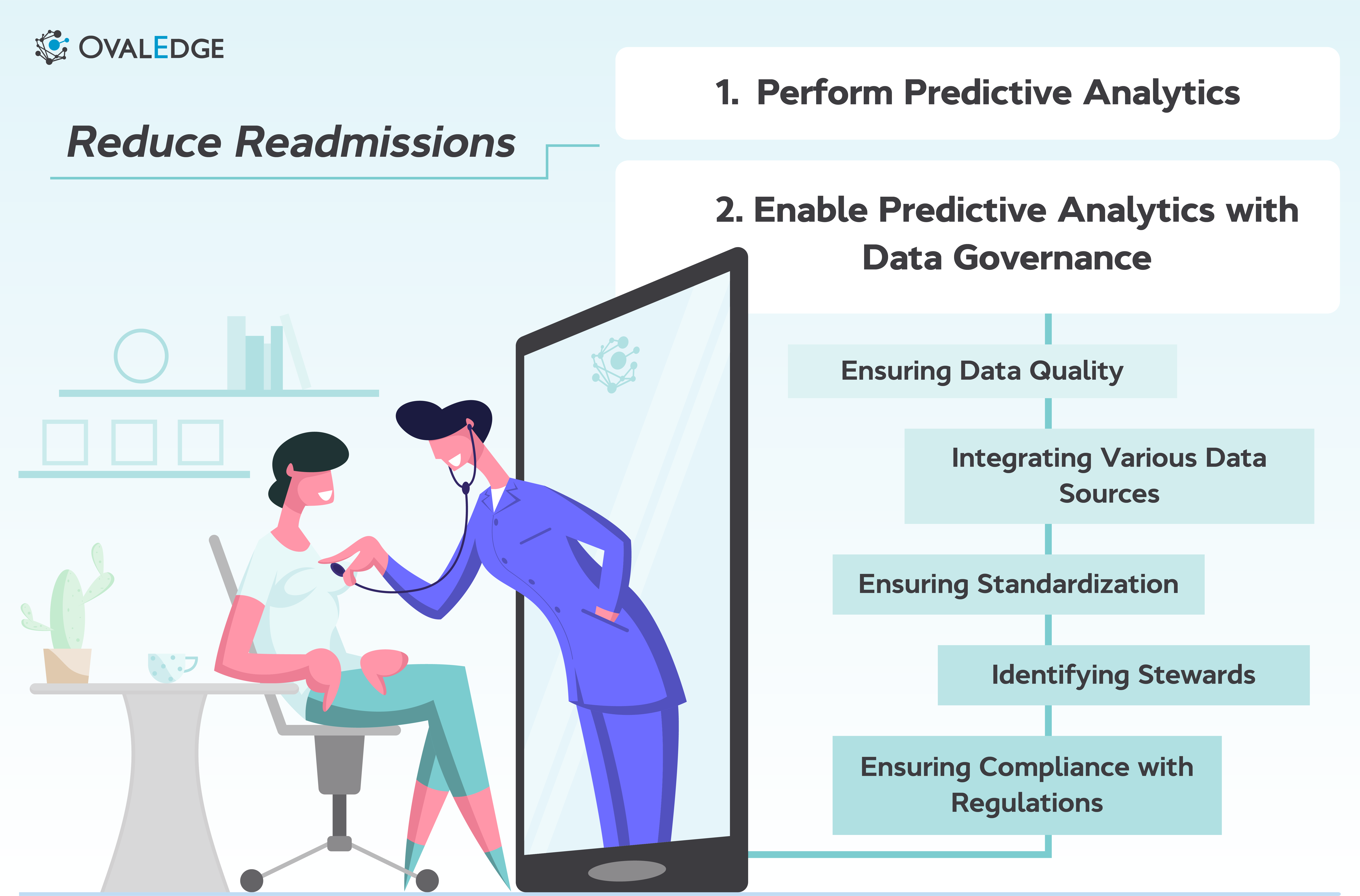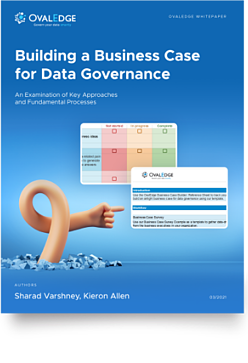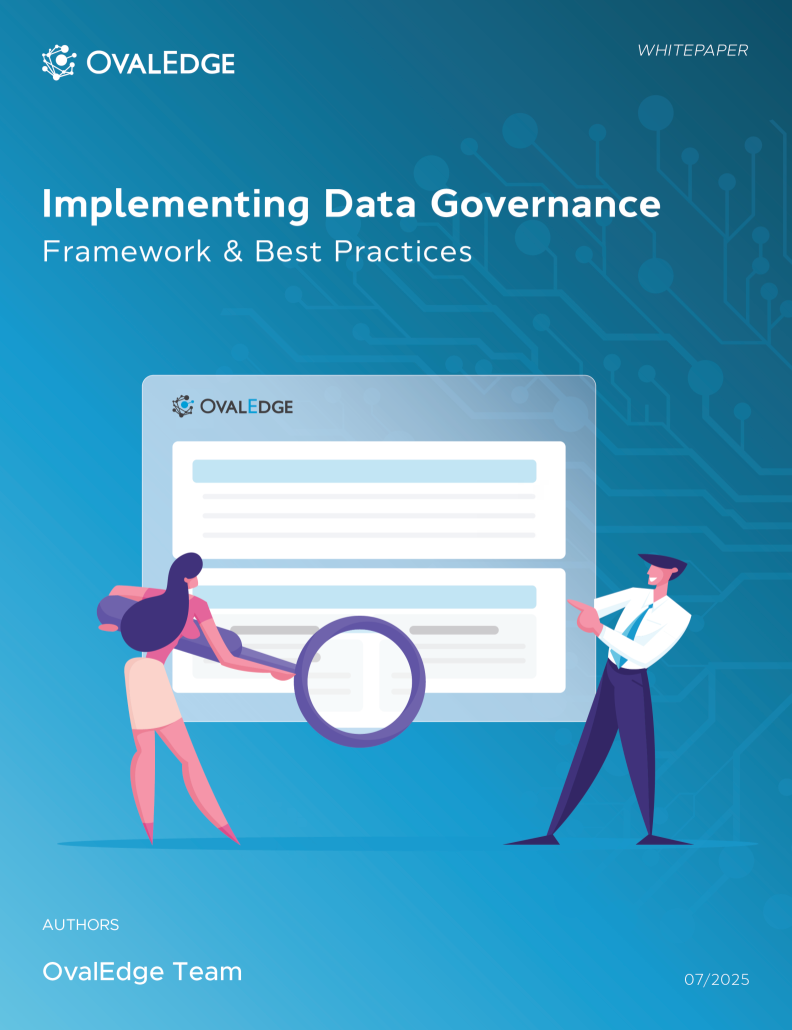Table of Contents

How Organizations Use Data Governance to Cut Patient Readmissions
Readmission rate is a key financial and operational `metric for many healthcare providers in the US. This blog shows how CDOs can leverage data governance to help US hospitals reduce patient readmissions.
At the University of Kansas, David Wild, vice president of lean promotion, discovered that patients with diabetes were more likely than other patients to be readmitted 3 times within 90 days at the nonprofit, academic medical center.
Using analytics, Dr Wild found that the biggest drivers of readmission for diabetes patients were restricted access to follow-up care, patient discharge disposition, and chronic conditions.
With this insight, patients who were readmitted to the hospital three times in 90 days are connected with a case manager who helped them secure follow-up care. On an average day, five to nine inpatients meet that criteria, says Wild.
The initiative enabled the hospital to reduce readmission rates for diabetes patients from 25% to 13.9%.
“The initiative enabled the hospital to reduce readmission rates for diabetes patients from 25% to 13.9%.”
The above is one example of how predictive analytics can help healthcare institutions avoid significant penalties associated with multiple readmissions.
Healthcare data governance is the cornerstone for improving patient outcomes and reducing readmissions. Implementing robust governance frameworks ensures that hospitals can securely manage diverse clinical, operational, and claims data, aligning all stakeholders around a unified data strategy. Recent studies show that healthcare organizations using rigorous data governance see up to a 20% reduction in readmission rates, thanks to improved data accuracy and compliance
Understanding Readmission Penalties
In the US, hospitals with higher readmissions compared to national averages can be docked a 1% to 3% penalty on reimbursement from CMS.
|
A few facts:
Source: Simplr |
Now, avoiding penalties isn't the only reason for reducing readmission rates. High readmission rates also put a strain on resources, such as beds, staff, and equipment.
Beyond this, hospitals with high readmission rates may also suffer reputational damage, making it harder to attract new patients and retain existing ones.
Predictive Analytics Drives Targeted Interventions
Predictive models use historical data to create models that identify the high-risk patients. These patients can then be provided targeted interventions to prevent readmissions.
Below are two more case studies where predictive models led to targeted interventions and eventual reduction in readmissions.
Physicians at Carolinas Health Care are able to predict their patients’ 30-day readmission risk with nearly 80% statistical accuracy.
“Using data analysis, we can identify each patient’s level of risk of requiring readmission, and determine pre-release care options and post-release support that can reduce this risk.”
- Seth Nore, CHS’ director of information services, EMR management.
University of Kansas uses machine learning and predictive analytics for identifying patients at the highest risk of readmission and then guiding clinical interventions. This has led to a 39% reduction in 30-day readmission rates.
Predictive analytics for readmissions has emerged as a vital tool—leveraging historical and real-time health data to identify at-risk patients before they are discharged. By integrating predictive models such as the LACE Index and machine learning algorithms, hospitals proactively target high-risk patients for follow-up care, supporting interventions that can reduce readmission rates by up to 25% over two years.
Data Governance as a Crucial Enabler for Predictive Analytics
Data governance is a crucial enabler for predictive analytics. When it isn’t present, it’s very challenging to identify data sources. Even when data teams do find the data they need, there is no standardization in place, meaning the data is of low-quality, making it impossible to use to make accurate predictions. Ultimately, when it comes to predictive analytics, data governance can help in the following ways can help in following ways:
Integrating Various Data Sources: Facilitating the integration of data from various sources, such as Electronic Health Records (EHRs), patient surveys, patient billing systems, and clinical outcomes, into a cohesive dataset.
Ensuring Standardization: Establishes standard protocols and procedures for data collection, storage, and usage. Standardizing data definitions and improving data quality across multiple sources.
Ensuring Data Quality: Ensuring that data used in predictive models is accurate. Addressing issues such as duplicate records, incomplete data, and inconsistent data formats.
Ensuring compliance with Regulations: Ensures that predictive models comply with regulations such as HIPAA, safeguarding patient privacy while allowing for the use of data in predictive analytics.
One of the core steps to achieving these objectives is to establish a network of data stewards.
Data standardization in hospitals is essential for effective prediction and intervention. Standardizing formats across electronic health records (EHRs), claims, and patient monitoring systems guarantees accurate, comprehensive data feeds for analytics and decision-making. Best practices include automated integration processes and regular validation to minimize manual errors, ensuring consistent data quality for all predictive tools.
How can data governance reduce patient readmissions?
- By enabling seamless integration of multiple data sources, maintaining high data quality, and supporting real-time analytics, governance helps care teams identify high-risk individuals, intervene early, and measure the effectiveness of strategies.
- Hospitals with strong governance protocols report faster identification of gaps and better post-discharge communication with patients.
Why is data governance important in healthcare readmission management?
- Effective governance increases the utility of predictive models, supports regulatory compliance, and safeguards patient information.
- This minimizes costly penalties due to excessive readmissions enforced by programs like CMS’s HRRP, while improving patient care standards.
Getting Started with Data Governance
The first step to undertaking a data governance program is to centralize your data assets. This involves collecting all of your metadata and making it available in a single location, namely a data catalog. The second crucial step, and one that is of particular importance when establishing a basis for predictive analytics is identifying data stewards.
Identifying stewards enables organizations to establish clear data ownership and accountability and kickstarts the process of defining policies for data access and usage.
Data stewards ensure:
- Data is well-cataloged
- Data is clearly structure and follow well-defined standards
- Data sources are known and lineage, where the data comes from and where it goes, is publicized
- Data is up to date and of high-quality
- Data is compliant with the regulatory requirements.
How OvalEdge helps
OvalEdge has all the features including data catalog, data quality tools, a business glossary, and access governance features to govern all aspects of data. Furthermore, we make it easy for your organization to establish a network of data stewards to manage standards.
Readmission data stewards can easily manage patient readmission data, step-by-step, from source systems like Epic to data warehouses, data lakes, and reporting systems like PowerBI/Tableau in a single platform through a simple user interface. They can leverage our data quality module to ensure data accuracy. And, using our data lineage tools, prove the legitimacy of the data by tracing it back to the source.
These lineage tools are also incredibly important for analysis, when healthcare teams need to find the root cause of patient readmission rates so they can actively work to lower them. OvalEdge enables data teams to find and analyze source data and track the lineage to find the root cause of elevated readmission rates. Finally, OvalEdge enables users to catalog all of their metadata in a single, centralized space. This eliminates silos and provides data teams with a clear, manageable mechanism to manage all patient data.
FAQs
- What is healthcare data governance and how does it help reduce readmissions?
Healthcare data governance is the discipline of managing patient, clinical, and claims data for accuracy, security, and compliance. By ensuring high data quality and seamless integration, governance enables teams to predict and prevent readmissions through data-driven interventions. - How does predictive analytics help in managing patient readmissions?
Predictive analytics for readmissions uses data mining and advanced modeling to identify patients at high risk for readmission. These models inform care teams and prompt timely follow-up, resulting in measurable declines in readmission rates. - Why is data standardization important in hospitals?
Data standardization ensures consistent formatting and validation for all patient-related records. This enables accurate analysis, efficient sharing across departments, and reliable inputs for predictive models—critical for effective readmission management. - What are the most effective strategies for hospitals to reduce patient readmissions using data?
Effective strategies include implementing predictive models, integrating data sources (EHR, claims, SDOH), automating data feeds, and linking analytics dashboards to actionable interventions. Hospitals achieve up to 25% reductions in readmissions by following these best practices. - How does data governance aid compliance with healthcare regulations on readmissions?
It ensures all data management processes support regulatory requirements such as CMS’s HRRP. Governance frameworks document and monitor quality metrics, support audit trails, and maintain privacy, minimizing monetary penalties and enhancing overall care.
OvalEdge recognized as a leader in data governance solutions
.png?width=1081&height=173&name=Forrester%201%20(1).png)
“Reference customers have repeatedly mentioned the great customer service they receive along with the support for their custom requirements, facilitating time to value. OvalEdge fits well with organizations prioritizing business user empowerment within their data governance strategy.”
.png?width=1081&height=241&name=KC%20-%20Logo%201%20(1).png)
“Reference customers have repeatedly mentioned the great customer service they receive along with the support for their custom requirements, facilitating time to value. OvalEdge fits well with organizations prioritizing business user empowerment within their data governance strategy.”
Gartner, Magic Quadrant for Data and Analytics Governance Platforms, January 2025
Gartner does not endorse any vendor, product or service depicted in its research publications, and does not advise technology users to select only those vendors with the highest ratings or other designation. Gartner research publications consist of the opinions of Gartner’s research organization and should not be construed as statements of fact. Gartner disclaims all warranties, expressed or implied, with respect to this research, including any warranties of merchantability or fitness for a particular purpose.
GARTNER and MAGIC QUADRANT are registered trademarks of Gartner, Inc. and/or its affiliates in the U.S. and internationally and are used herein with permission. All rights reserved.


.webp)


